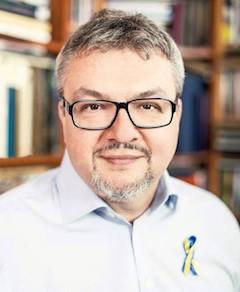 Leszek Jodlinski
Leszek Jodlinski
Director
Upper Silesian Museum in Bytom, Poland
Young Leaders Program (’07)
Please tell us about your career path so far. What is your area of specialization and how did you come to work in this area?
After concluding my studies at GRIPS, I returned to the museum sector that I was active in prior to my studying in Tokyo. I was nominated (as the result of a contest) for Director General of the Silesian Museum in Katowice (Upper Silesia, south of Poland). As a civil servant, graduate of the National School of Public Administration and GRIPS (and last but not least as art historian by my first profession) I was prepared to manage the museum, and along with this to supervise and be responsible for the construction of the new museum building (with a budget of approximately 60 million euro). The project was realized successfully.
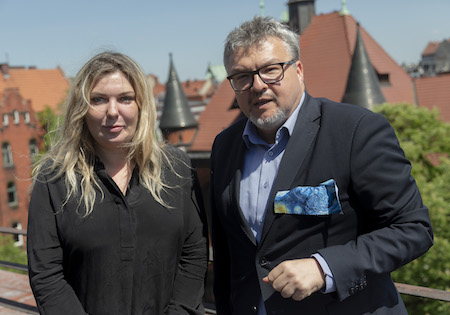
On the museum rooftop with Ms Dorota Kobiela, the OSCAR nominee for “Loving Vincent”
From 2013, I was working for the Czech museum in Opava for 1,5 year after which I moved to an American software provider for museums and galleries, Gallery Systems, one of the biggest in the world. From 2016 I am back in Upper Silesia (where I was born) and I occupy the position of Director of the Upper Silesian Museum in Bytom. At the same time I teach at the Silesian University and write some articles for the press and periodicals.
You have been a manager of cultural institutions for many years. What are some of the biggest challenges you face in your work? And what have been the most interesting or rewarding aspects of your career thus far?
That’s a difficult question. First, this kind of activities gives you the everyday challenges to solve the problems to co-operate successfully with people, some of them presenting the highest level of creativity and individualism. The most rewarding aspect is being connected with the creativity that the cultural sector gives you. You have to combine economic issues with artistic ones or referring to tangible and intangible heritage, tradition. You should be open to phenomena in the world around you and be able to pick the issues that would interest people.
As the Museum Director at the time you were responsible for the project management and overseeing the construction of the prestigious New Silesian Museum. Please tell us more about this.
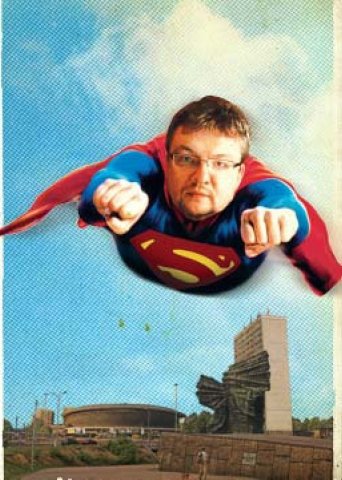
Leszek as superhero of the month (2008)
That was a very exciting and demanding time. Within the designed time span of 4 years and based upon EU funds I was responsible for building from the scratch the new site of the ultramodern Silesian Museum. What was even more challenging was the fact that because of many reasons – one of them was the determination to preserve the historic landscape of a previous coal-mine – the structure of the museum was to be located below ground level which is not that typical for the museum buildings around the world. The construction was finished in 2013 and the museum opened to the public in 2015. Thanks to my managerial skills and of course the team I was working with, we saved almost 10 million euro on the originally planned budget.
You have also initiated a project that aims to make Polish painting galleries accessible to the blind. Please tell us more about this project and its outcomes.
Parallel to the construction of the new museum I developed new activities of the old museum, attracting thousands of new visitors in the following years; I am proud to say that the number of visitors tripled during my tenure. One such activity was the opening of the first (ever) painting gallery in Poland that is accessible to both regular visitors and the blind and partially blind persons in 2010.
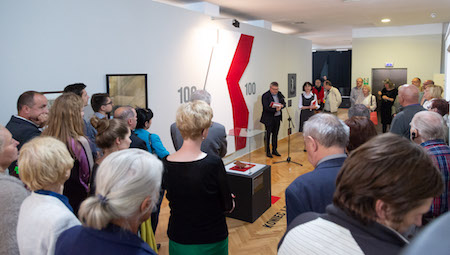
Leszek opening an exhibition of photographer Witalis Szołtys
That project was of great significance to me and I was often asked whether I initiated this because I had any relative or close person being handicapped in this way. Through some studies and classes I had with my students I had just realized how many people in Poland at that time (2009-2010) had no access to museums. I thought that it was not fair and one has to do something about it. We started the project using 3D printing in 2009 and in October 2010 our painting gallery was tailored to the needs of the visually impaired visitors. It was almost like revolution! All of a sudden we had people visiting a museum for the first time, even though they were for example 14 or15 years old. What also happened was that it benefitted our “regular visitors” since they were offered better treatment too. For the subsequent years we have promoted that program and idea in Poland and today the Silesian Museum offers one of the best programs in Poland for this category of visitors. It gives me great satisfaction!
Where do you see yourself in 10 years time?
No idea. At he moment we have a challenging political situation and culture has started to be a politically influenced domain. It does not help to answer your question. I would be happy to share my knowledge and expertise with some countries in Asia and worldwide. I want people living in Poland, or anywhere, to find museums as the places that belong to the modern world though they speak about the past (mostly).
What led you to GRIPS? What is the most important thing you got out of your studies here, and how has your experience at GRIPS prepared you for future endeavours?
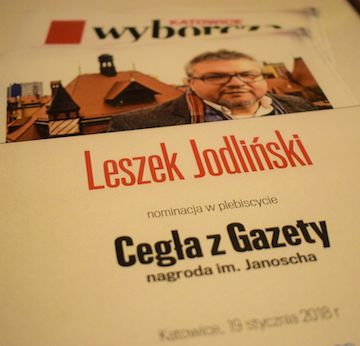
Certificate of the nomination for the Janosch Prize, 2018
GRIPS was an extremely important experience. At that time I was nominated by the authorities of the National School of Public Administration, the only higher education school of this kind in Poland. The most important aspect during my stay at GRIPS were my studies connected with the public policy domain and I wish I could do more in that area in Poland. Unfortunately, that’s not the case at the moment. What I highly appreciate though is my better understanding of Asia, of Japan naturally and the friends and colleagues I made from Asia and Africa. It has deepened my recognition for their careers, and the cultures they represented. GRIPS opens you to the world and I think this is a big thing!
Have you had any involvement, professional or otherwise, with Japan since your graduation?
Unfortunately not. A few occasional visits to the Japanese Embassy is probably not too much. I was close to publish my book on Japan history but was too busy with the Silesian Museum to conclude it. I would be most happy if the Japanese firms and legal entities would have some contacts with GRIPS graduates in Europe. I think we could do a lot of things together.
How do you maintain a balance between your work and the rest of your life? And what is your favorite thing to do when you are not working?
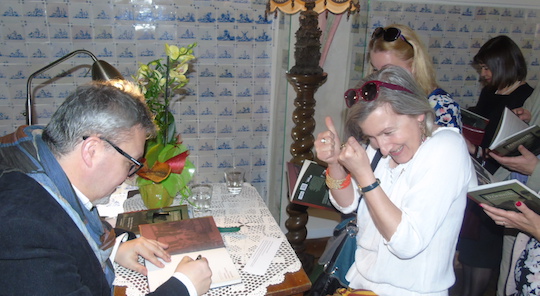
Leszek signing his book on an evening with happy readers
This balance is a hard thing to obtain. Japan knows karōshi 過労死 and sometimes I think I have sort of the same problem and I have to stop. Being responsible for the others does not help to achieve this balance. If possible I like to write (having my own blog), take pictures and to travel a lot. My next trip will lead me to the Middle East.
What are some of your fondest memories of your time spent at GRIPS? And what do you miss about Japan?
Another difficult question. If I say onsen you would say “ how obvious” :-). But if I say the onsen on Oshima Island (look on the map or recall your memories of Godzilla movie to find the place) I hope you will understand why I chose this memory.
If you could give one piece of advice to anyone considering studying at GRIPS what would it be?
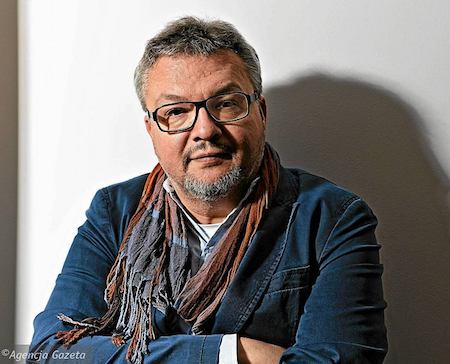 Probably I would say “prepare for the most exciting experience in your life, and be open”. Look around, do not hurry, understand as much as you can and experience. Sounds like Shinto to me :-), or just a piece of advice which can be translated into one of these mottos “leave what’s behind you and start anew”.
Probably I would say “prepare for the most exciting experience in your life, and be open”. Look around, do not hurry, understand as much as you can and experience. Sounds like Shinto to me :-), or just a piece of advice which can be translated into one of these mottos “leave what’s behind you and start anew”.
How would you like to maintain involved with the School? What do you expect from GRIPS as an alumnus and do you have any suggestions on how to further utilize the GRIPS alumni network?
I would start with a request to receive a GRIPS T-shirt (big European size please like XXL). This would not just be a nice gesture to GRIPS alumni, it would also help to promote the concept and the institution on the very basic level.
I would definitely recommend intensive networking among the GRIPS, alumni and the Japanese enterprises worldwide. We have been offered an excellent education in Japan and I think even if one speaks Japanese on level A1 or 2 that would still mean that there are opportunities to use our qualifications and our competences to the mutual benefit.
Thank you for offering me the honor to be the “Alumnus of the Month” and for your interesting questions. “Arigato gozaimasu”!





